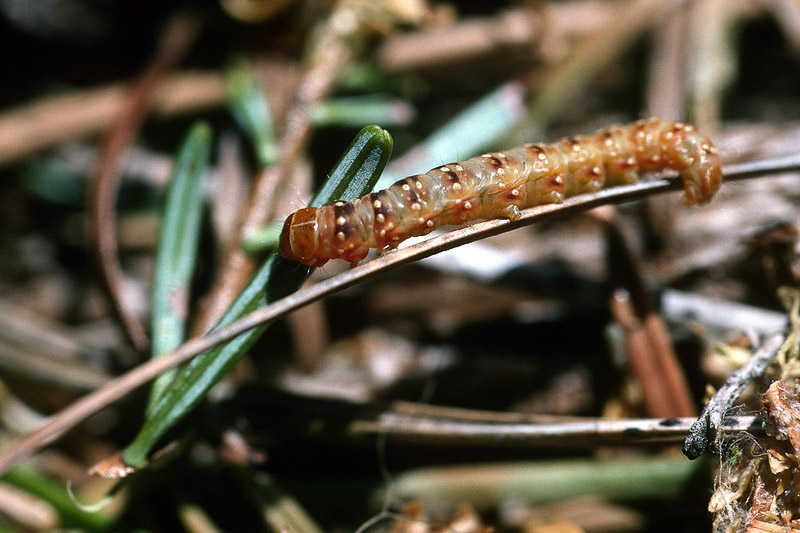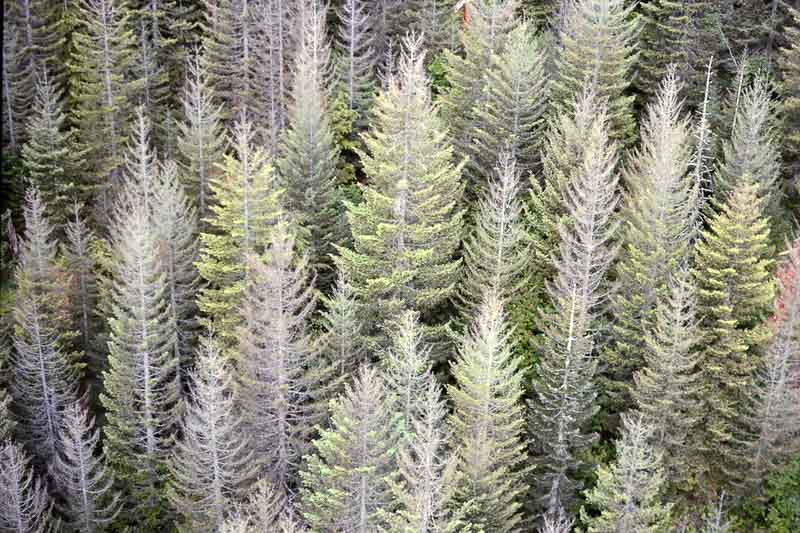The Spruce Budworm is a significant defoliating pest that primarily targets spruce and fir trees across North America
The spruce budworm (Choristoneura) is a significant defoliating insect of the family Tortricidae, known for its destructive outbreaks that can cause extensive damage to spruce and fir forests.
Spruce budworms primarily target species of spruce and fir trees as their host plants. The two most commonly infested species are balsam fir (Abies balsamea) and white spruce (Picea glauca). Other species that may also serve as hosts include:
It’s worth noting that the susceptibility of these tree species to spruce budworm infestation can vary based on a variety of factors, including the age and health of the tree, its location, and the overall density of host trees in the area. Mature and overmature stands of balsam fir and white spruce are particularly at risk during outbreak periods.
Spruce budworms are found across North America, from the Atlantic provinces of Canada, extending westward to the Rocky Mountains and southward into the northeastern United States. Outbreaks occur in cycles, approximately every 30-40 years, causing significant tree mortality and impacting timber production, wildlife habitats, and overall forest health.
During an outbreak, millions of hectares of trees can be severely defoliated. An outbreak may last several years.
The adult spruce budworm is a small, tan to reddish-brown moth with a wingspan of about 1 inch. The larvae or caterpillars, which cause the damage to the host trees, are approximately 1 inch long when fully grown. They vary in color from green to reddish-brown, with light-colored spots up and down their back.

The spruce budworm completes one generation per year, and its life cycle comprises four stages: egg, larva, pupa, and adult.
Adult moths lay eggs on the underside of the needles of host trees in late summer. The eggs are light green and are laid in a shingle-like fashion. They hatch into larvae in around 10 to 14 days. These larvae undergo six stages of development before pupation. Typically, first-instar caterpillars emerge by mid-August and ascend towards the branch tips in response to light, a process known as phototaxis. Some may be windborne on silken threads, dispersing over a large area and leading to many larvae death. The surviving larvae create cocoon-like shelters and molt into second-instar larvae without feeding on the host foliage.
Overwintering typically occurs on old flower scars, bark scales, or lichen-covered branches. By April or May, the second-instar larvae exit the cocoon and respond to light, moving towards the branch tips, which triggers another wind-based redistribution. On landing on suitable foliage, these larvae start feeding, generally on one-year-old foliage or directly into vegetative buds. They favor balsam fir flowers, with each larva typically mining one needle before molting into a third instar.
Late May or early June sees third-instar larvae feeding on new vegetative buds. If the food source depletes, they shift to fresh foliage. Late-stage larvae are present from early June to July. The fully grown sixth-instar larvae are about 0.75 to 1 inch long, dark brown with yellow spots, dark brown or black head and collar, and consume more foliage than other stages. They create feeding shelters by webbing shoots together, and if the population is high, resort to back-feeding on older foliage, resulting in smaller pupae and egg masses due to less nutritious food. As food scarcity increases, larvae drop to the understory, feeding on young trees or seedlings.
Pupation happens in protected areas or feeding shelters, with the pupa initially green, turning yellow, then dark brown. In the East, this stage occurs from late June for 8-12 days. In the West, pupae appear from mid-July to early August. Adults live for about 2 weeks without feeding. Mating occurs after females release a sex pheromone attracting males. Post-mating, females generally stay stationary until they’ve laid some of their eggs. Favorable weather can result in both male and female moths being carried to new locations by winds, aiding in population dispersion and expansion.
Spruce budworms feed on the buds, flowers, and foliage of host trees. They can cause significant defoliation, reduced tree growth, and, eventually, tree death. The severity of damage usually depends on the population size of the budworms and the age, health, and species of the host trees.
The most significant damage is caused by the larvae, which feed on the buds and needles. Initially, the larvae tunnel into the buds to feed, leading to distorted and dead new growth in the spring. As the larvae grow, they continue to consume new and old needles, causing extensive defoliation.
Heavy infestations can lead to the death of large branches or even entire trees, especially if the trees are subjected to repeated defoliation over several years. Trees that survive budworm infestations often exhibit reduced growth and are more susceptible to other pests and diseases.
Early detection of spruce budworm infestation can help mitigate the extent of the damage. Here are some signs to look for:
Feeding Damage: Look for new shoots that are discolored, wilted, or chewed on. As the infestation progresses, you may also notice older needles turning brown and falling off, leaving trees looking sparse and unhealthy.
Silken Threads and Cocoons: The larvae produce silken threads to move between feeding sites. These threads, along with the small, silken cocoons where the larvae pupate, can often be seen on the undersides of branches.
Frass: The presence of frass (insect excrement) is another sign of infestation. This can often be seen on the ground beneath infested trees or on lower branches.
Moths: Adult moths, which are small and brownish-gray, can be observed during the summer months. However, they do not cause damage and their presence does not necessarily indicate a significant infestation.
The most accurate way to detect and monitor spruce budworm populations is through pheromone trapping and direct examination of buds and shoots for signs of feeding damage. Regular monitoring can help detect the early stages of an infestation and guide the timing of control measures.

The prevention and control of spruce budworm infestations can be a significant challenge, particularly during outbreak periods when the pest’s populations are high. However, a combination of biological, chemical, and cultural control methods can help to manage infestations.
Despite these strategies, it’s important to note that complete eradication of the spruce budworm is neither feasible nor desirable, as the pest plays an integral role in the ecology of spruce and fir forests. Instead, the goal of budworm management is to minimize the damage caused during outbreak periods and promote the overall health and resilience of the forest.
Create a membership account to save your garden designs and to view them on any device.
Becoming a contributing member of Gardenia is easy and can be done in just a few minutes. If you provide us with your name, email address and the payment of a modest $25 annual membership fee, you will become a full member, enabling you to design and save up to 25 of your garden design ideas.
Join now and start creating your dream garden!
Create a membership account to save your garden designs and to view them on any device.
Becoming a contributing member of Gardenia is easy and can be done in just a few minutes. If you provide us with your name, email address and the payment of a modest $25 annual membership fee, you will become a full member, enabling you to design and save up to 25 of your garden design ideas.
Join now and start creating your dream garden!